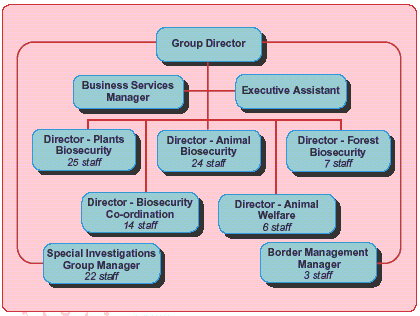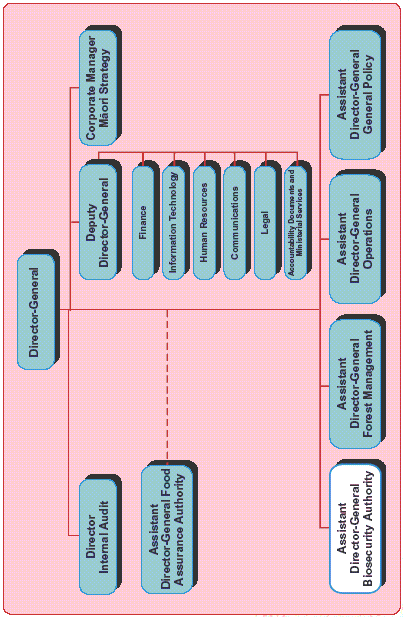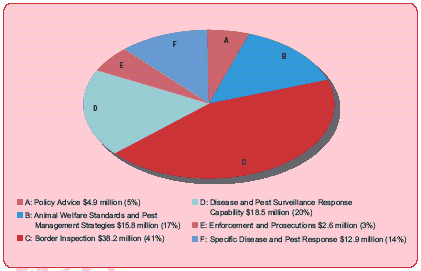Part 5: MAF Biosecurity — Organisation and Management
- Structure and funding
- Contracting for biosecurity services
- How MAF Biosecurity manages its workload
- Goals and performance measures
Structure and Funding
5.1
MAF Biosecurity is responsible for developing and implementing strategies to achieve good biosecurity outcomes. Its mission is:
to protect New Zealand’s unique biodiversity and facilitate exports by managing risks to plant and animal health and animal welfare.
5.2
MAF Biosecurity protects the biodiversity by managing risks to animal, plant, and forest health. Its management is based on:
- effective biosecurity risk assessment and management programmes;
- surveillance and emergency response plans;
- enforcement and compliance strategies; and
- effective education and awareness programmes.
5.3
MAF Biosecurity is headed by a Group Director (Assistant Director-General Biosecurity Authority) and includes three groups with a sector orientation (see Figure 8 on page 74):
- animal biosecurity;
- plants biosecurity; and
- forest biosecurity.
5.4
MAF Biosecurity has four other groups:
- The Biosecurity Co-ordination Group is responsible for co-ordinating biosecurity policy, overseeing international agreements, contributing to risk analyses to minimise threats to indigenous flora and fauna, and managing contracts. The group also provides administrative and advisory support to the Biosecurity Council and its advisory groups, and the Pest Management Strategy Advisory Committee.
- The Special Investigations Group is responsible for responding to all serious breaches of the legislation administered by MAF. The group is also responsible for the administration of the infringement notice (instant fines) system, and employs solicitors and experienced law enforcement officers who investigate suspected breaches of legislation.
- The Border Management Group is responsible for developing import health standards for pathways and goods such as air and sea containers, mail items, used vehicles, machinery and tyres, and for ensuring that the requirements for aircraft, vessel, and passenger clearance are met.
- The Animal Welfare Group is responsible for promoting policies to ensure that animals are treated humanely. The group investigates all complaints of cruelty to animals, resolves animal welfare problems, identifies research priorities, liases with New Zealand and international agencies involved in animal welfare, and develops a New Zealand position in relation to animal welfare and international animal trade.
Figure 8
Organisation of MAF Biosecurity

5.5
Figure 9 on the opposite page shows the relationship of MAF Biosecurity with the other groups within MAF.
Figure 9
MAF Biosecurity in Relation to Other MAF Groups

Note – Policy and Operations groups also have biosecurity roles, but these were not the subject of our audit.
5.6
Of the $130.1 million appropriated to MAF for biosecurity in 2001-02, $92.9 million in departmental appropriations related to goods and services provided by MAF and was allocated among output classes as shown in Figure 10 below. The remaining appropriations, $37.2 million, were allocated to the following activities:
- control of tuberculosis carriers ($33.2 million);
- subscriptions to international organisations ($0.2 million);
- compensation payments to farmers and beekeepers ($1.1 million); and
- provision of services related to border control activities ($2.7 million).
Figure 10
Departmental Appropriations for MAF Biosecurity 2001-02

Source: The Supplementary Estimates of Appropriations for the Government of New Zealand for the Year Ending 30 June 2002, pages 38-39 (listed in the order in which they appear in the Supplementary Estimates).
Contracting for Biosecurity Services
5.7
Before the delivery of biosecurity services was made contestable, it was MAF’s responsibility to deliver as well as design a wide range of biosecurity services. However, MAF Biosecurity now contracts out the delivery of most services, or has internal contracts or memoranda of understanding with other parts of MAF – for example, border control and quarantine services, and disease investigation.
5.8
There are about 75 current contracts for the provision of biosecurity services, with a total value of $16 million, which are managed by the Contract Management Group within the Biosecurity Co-ordination Group.
5.9
MAF Biosecurity has contracts with a wide range of organisations: government departments, state-owned enterprises, private sector bodies, and individuals. Contracted services include surveillance programmes, specific incursion response activities, and other biosecurity-related services.
5.10
Decentralisation of service delivery has left a very small group of MAF Biosecurity officials in Wellington responsible for overseeing operations in other parts of the country. MAF Biosecurity now relies heavily on contracted project managers to co-ordinate large incursion responses – such as the painted apple moth in Auckland. Problems experienced in the painted apple moth response were due in part to poor co-ordination between MAF Biosecurity and those responsible for incursion management in the field (see Case Studies page 66).
5.11
MAF needs assurance that its service providers can meet their contracted obligations. To do this, MAF audits the performance of its service providers to ensure that they are able to comply with their contractual obligations. In addition, each year MAF runs incursion response simulation exercises involving MAF officials, relevant industry groups, and the contracted service providers – which also provide a means of assessing the performance of its service providers.
How MAF Biosecurity Manages Its Workload
Key Finding
5.12
Timetables for planned work and reviews of parts of the Biosecurity Programme are often changed as a result of the need for MAF Biosecurity to reprioritise its workload – in particular, in relation to responses to new pest and disease incursions.
5.13
MAF Biosecurity often has to respond quickly to pest and disease incursions. The unpredictable nature of this type of work results in the need to postpone planned work programmes.
5.14
MAF Biosecurity is currently undertaking, or has commissioned, a large number of reviews and projects. These include:
- a review of the risks posed by sea containers and a review of the surveillance programme; and
- a series of projects to enhance preparedness for foot and mouth disease.
5.15
The conduct and co-ordination of the review programme is also disrupted by the unplanned but overriding priorities that emerge throughout the year.
5.16
Workload issues are explored further in paragraphs 6.19-6.32 on pages 87- 90, which look at meeting the demand for import health standards.
Goals and Performance Measures
Key Finding
5.17
Just as there are no clear objectives or outcomes for biosecurity generally, there are no clear performance measures against which MAF’s implementation of the Biosecurity Programme can be assessed.
5.18
MAF Biosecurity undertakes a range of activities to implement the Biosecurity Programme. The aim of the Programme is to: have in place a comprehensive and dynamic programme that preserves and protects New Zealand’s indigenous and productive biodiversity.
5.19
It is not possible to keep all unwanted organisms out of the country. The concept of a desired or appropriate level of protection (see paragraphs 4.72-4.75 on page 63) is reflected in the stated goals of the programme: Government has responsibility for indicating what level of protection it is wanting its Biosecurity Programme to achieve; and Government determines this level of protection by agreeing government policy, enacting domestic legislation and ratifying international treaties.
5.20
While providing guidance for the development of biosecurity policy, these goals do not indicate what the Biosecurity Programme is designed to achieve. The development of the Biosecurity Strategy (see paragraph 4.99 on page 68) provides an opportunity for MAF to review Programme goals and measures of performance.
Recommendations
5.21
MAF Biosecurity should:
- improve its strategic oversight of ongoing reviews (such as the sea containers review) to ensure that the effects of any unforeseen delays are identified and managed; and
- review the stated goals of the Biosecurity Programme in line with the Biosecurity Strategy, and develop performance measures against which the success of biosecurity activities can be measured.
